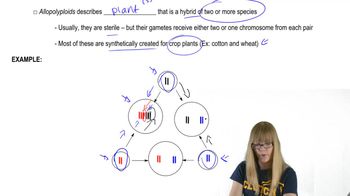Here are the essential concepts you must grasp in order to answer the question correctly.
Chromosomal Abnormalities
Chromosomal abnormalities occur when there is a deviation from the normal number or structure of chromosomes. In the case of Down syndrome, also known as trisomy 21, an individual has three copies of chromosome 21 instead of the usual two. This can happen due to nondisjunction during meiosis, where chromosomes fail to separate properly, leading to gametes with an abnormal number of chromosomes.
Recommended video:
Nondisjunction
Nondisjunction is the failure of homologous chromosomes or sister chromatids to separate properly during cell division. This can occur during meiosis, resulting in gametes that have an extra chromosome or are missing one. If such a gamete participates in fertilization, it can lead to conditions like Down syndrome, where the resulting zygote has an abnormal number of chromosomes.
Recommended video:
Phenotype vs. Genotype
Phenotype refers to the observable characteristics or traits of an organism, while genotype refers to the genetic makeup. In this scenario, the boy with Down syndrome has a distinct phenotype due to his extra chromosome, but his parents and sisters may have a normal phenotype despite having 45 chromosomes, possibly due to a balanced chromosomal rearrangement or a different chromosomal abnormality that does not affect their phenotype.
Recommended video:
 Verified step by step guidance
Verified step by step guidance Verified video answer for a similar problem:
Verified video answer for a similar problem:



 12:42m
12:42m